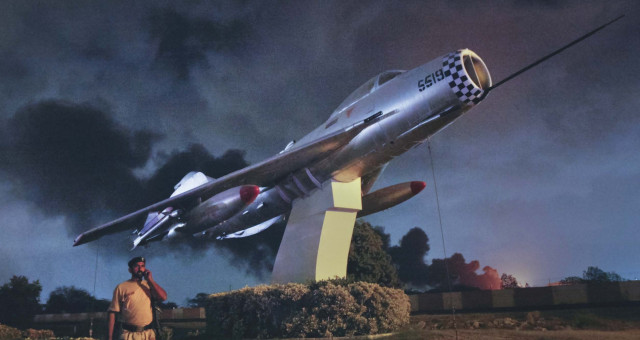Conspiracy theories: Is the hidden hand Indian, internal or existential?
The attack on the navy buses was just yesterday as was the motorcycle bomb — what lies ahead?.

The questions and conspiracy theories about the well-executed attack on PNS Mehran have begun to circulate. But a look at existing patterns, threats and warning signs helps connect the dots.
Target
While other attacks have targeted military personnel, the PNS Mehran attack is different in that it directly targeted the P-3C Orion aircraft. “The attack has rendered the navy deaf and dumb,” said security analyst Ikram Sehgal. “The P-3C aircraft acts as the navy’s ears and eyes. There are three basic elements — anti-submarine warfare, radar capabilities and electronic intelligence.”
According to the US Navy, “Originally designed as a land-based, long-range, anti-submarine warfare patrol aircraft, the P-3C’s mission has evolved in the late 1990s and early 21st century to include surveillance of the battle space, either at sea or over land.” The aircraft attacked on Sunday were inducted into the navy in June 2010, as part of US military assistance to Pakistan. A press release at the time said that Pakistan Navy will receive eight P-3C aircraft by 2012.
Why the navy?
Pakistan’s armed forces have been under attack by militants for several years now, however the navy has rarely been targeted. In 2008, seven people were killed in a suicide attack at Lahore’s Naval War College. On December 1, 2009, a suicide bomber blew himself up at the naval headquarters in Islamabad.
On April 26, 2011, four people were killed and 26 were injured in twin bomb blasts on naval buses in Karachi. Two days later, six people were killed and seven injured in another attack on a bus carrying naval personnel near the Karsaz base. “These were soft targets,” says Sehgal. “But it should have been questioned as to why technicians, who were going to and from the naval base, were being targeted.”
While Tehrik-i-Taliban Pakistan spokesperson Ehsanullah Ehsan claimed responsibility for the attack, Sehgal believes that the beneficiaries of Sunday’s attack are countries that have ‘had designs on Pakistan’, and that this had “India’s Research and Analysis Wing’s signature all over it”. He said it was “far fetched” to believe that the attack could be retribution for the Pakistan Navy’s role in Combined Task Force 151, an international anti-piracy fleet that was commanded by the Pakistan Navy earlier this year.
Internal involvement
The security of Pakistan’s military bases has been in question for several years now. The attack on the military’s general headquarters in Rawalpindi in 2009 as well as frequent attacks on security check posts, bases and training centres is part of a pattern, both of infiltration of and radicalisation in the security forces, and the lack of adequate security measures.
A precedent for involvement by military personnel exists. Investigation into an assassination attempt on former president General (retd) Pervez Musharraf found that the ammunition had been taken from a Pakistan Air Force (PAF) depot. Seven military officials — six of whom were from the air force — were convicted by a military court along with six civilians. According to a Dawn report in 2010, explosives used in the attacks on Karachi’s Abdullah Shah Ghazi shrine were ‘sophisticated military explosives’.
A US embassy cable from 2006, which was released this month by WikiLeaks, highlights radicalisation in the air force. The cable quotes then-Deputy Chief of Air Staff for Operations Air Vice Marshal Khalid Chaudhry as saying that the airmen, most of who came from rural villages, were being radicalised by extremist clerics.
The cable quotes Chaudhry as saying, “You can’t imagine what a hard time we have trying to get them to trim their beards.”
The cable also reveals that Chaudhry claimed “to receive monthly reports of acts of petty sabotage, which he interpreted as an effort by extremists among the enlisted ranks to prevent PAF aircraft from being deployed in support of security operations in the Federally Administrated Tribal Areas along the Afghan border.”
Radicalisation in the security forces was highlighted earlier this year when Punjab Governor Salmaan Taseer was assassinated by a member of the Elite Force squad in Islamabad on January 4. A Los Angeles Times report in February highlighted the case of Zahid Manzoor Bajwa, a Punjab police official who had access to intelligence reports and is believed to have passed them on to the Taliban.
The PNS Mehran attack would have also required significant surveillance, which militant organisations have been able to conduct in the past, given their success at attacking the military’s Rawalpindi headquarters and buildings belonging to the Inter-Services Intelligence, Federal Investigation Agency and the Crime Investigation Department.
In the early 2000s, al Qaeda operatives had reportedly surveyed Karachi’s ports in preparation for a planned attack on the Strait of Hormuz and other ports used by the US Navy, according to the files of Guantanamo Bay detainees published by WikiLeaks.
A unique experience
A huge billboard outside the naval air force headquarters, which came under sustained attack for hours on Monday, says it all - “Pakistan Air Force Museum. Unique experience”.
“If these people can just enter a military base like this, then how can any Pakistani feel safe?” asked Mazhar Iqbal, 28, engineering company administrator taking a lunch break in the shade outside the complex where a crowd had gathered on a patch of grass to watch journalists set up camp as much as anything
He said he was from an insecure area of the city already infamous as a source of funding for militant groups.
“The government and the army are just corrupt. We need new leaders with a vision for Pakistan.”
Moin Babar, 35, a technical engineer, said people were trying to understand how the militants made it inside. “I heard that 15 went in through a sewer,” he said. Kamran Khalil, 48, a civil engineer, suggested, like many others, a conspiracy. “How can this happen? It’s taking them so long to resolve the issue. India or the CIA could have been behind this. They want to show that Pakistan forces are ineffective.”
Many in Pakistan were furious with the US operation to kill Bin Laden without sharing any intelligence beforehand with Islamabad, which they saw as a severe breach of sovereignty. “This is all a reaction to American policy in Pakistan,” said Atif Ali, a 30-year-old construction worker, standing near one billboard advertising audio equipment in which a beautiful woman says “Let’s play” and another advertising pizza.
with additional input by reuters
Published in The Express Tribune, May 24th, 2011.



















COMMENTS
Comments are moderated and generally will be posted if they are on-topic and not abusive.
For more information, please see our Comments FAQ